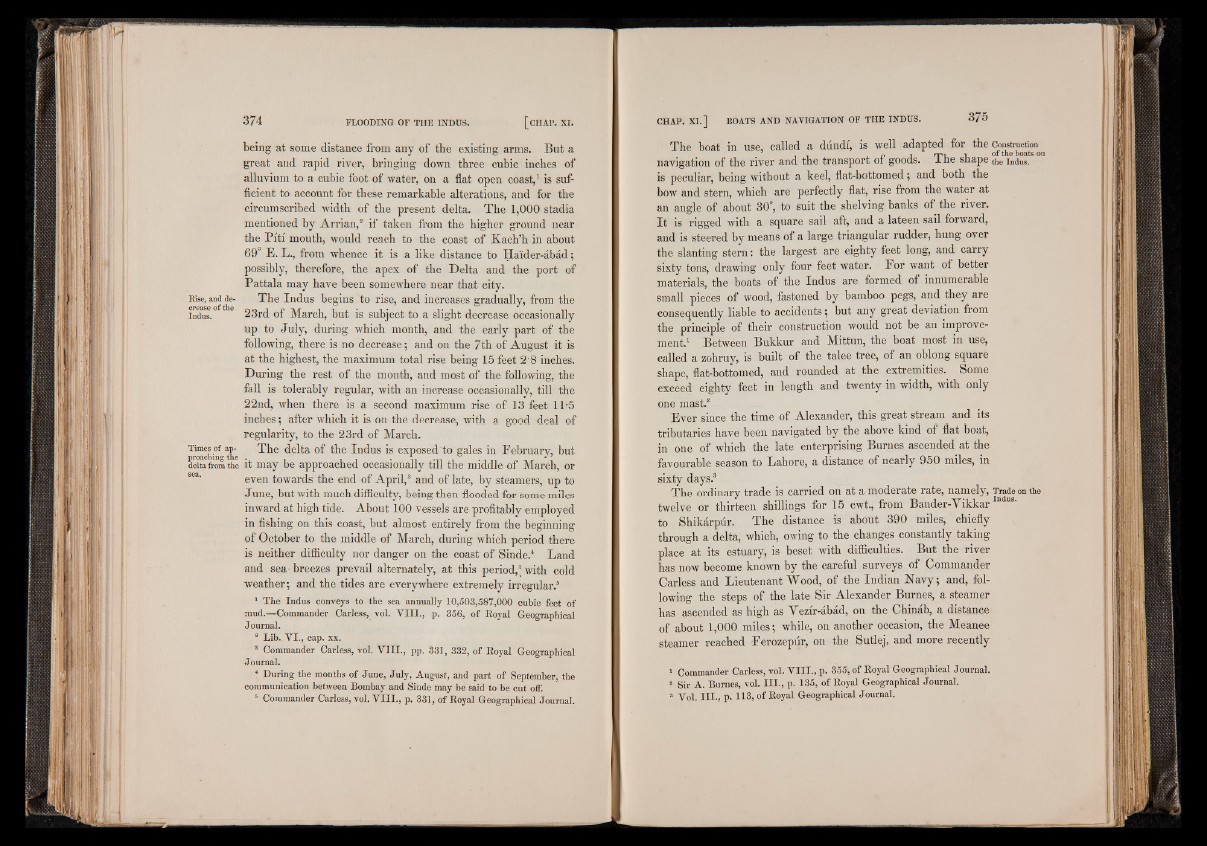
being at some distance from any of the existing arms. But a
great and rapid river, bringing down three cubic inches of
alluvium to a cubic foot of water, on a flat open coast,1 is sufficient
to account for these remarkable alterations, and for the
circumscribed width of the present delta. The 1,000 stadia
mentioned by Arrian,2 if taken from the higher ground near
the Piti mouth, would reach to the coast of Kach’h in about
69° E. L., from whence it is a like distance to Ha'ider-abad;
possibly, therefore, the apex of the Delta and the port of
Pattala may have been somewhere near that city.
Eise, and de- The Indus begins to rise, and increases gradually, from the
Indus. 23rd of March, but is subject to a slight decrease occasionally
up to July, during which month, and the early part of the
following, there is no decrease; and on the 7th of August it is
at the highest, the maximum total rise being 15 feet 2 8 inches.
During the rest of the month, and most of the following, the
fall is tolerably regular, with an increase occasionally, till the
22nd, when there is a second maximum rise of 13 feet 11-5
inches; after which it is on the decrease, with a good deal of
regularity, to the 23rd of March.
Times of ap- The delta of the Indus is exposed to gales in February, but proachmg the . . . • i ►
delta from the it may be approached occasionally till the middle of March, or
even towards the end of April,3 and of late, by steamers, up to
June, but with much difficulty, being then flooded for some miles
inward at high tide. About 100 vessels are profitably employed
in fishing on this coast, but almost entirely from the beginning
of October to the middle of March, during which period there
is neither difficulty nor danger on the coast of Sinde.4 Land
and sea - breezes prevail alternately, at this period,4 with cold
weather; and the tides are everywhere extremely irregular.5
1 The Indus conveys to the sea annually 10,503,587,000 cubic feet of
mud.—Commander Carless, vol. V I I I ., p. 356, o f Royal Geographical
Journal.
2 Lib. V I., cap. xx.
3 Commander Carless, vol. V I I I ., pp. 331, 332, of Royal Geographical
Journal.
4 During the months of June, July, August, and part of September, the
communication between Bombay and Sinde may be said to be cut off.
5 Commander Carless, vol. V I I I ., p. 331, of Royal Geographical Journal.
The boat in use, called a dundi, is well adapted for the Construction
. , n j rn r i of the boats on navigation of the river and the transport 01 goods. Xne snapethe Indus,
is peculiar, being without a keel, flat-bottomed; and both the
bow and stern, which are perfectly flat, rise from the water at
an angle of about 30°, to suit the shelving banks of the river.
It is rigged with a square sail aft, and a lateen sad forward,
and is steered by means of a large triangular rudder, hung over
the slanting stern: the largest are eighty feet long, and carry
sixty tons, drawing only four feet water. For want of better
materials, the boats of the Indus are formed of innumerable
small pieces of wood, fastened by bamboo pegs, and they are
consequently liable to accidents; but any great deviation from
the principle of their construction would not be an improvement.
1 Between Bukkur and Mittun, the boat most in use,
called a zohruy, is built of the talee tree, of an oblong square
shape, flat-bottomed, and rounded at the extremities. Some
exceed eighty feet in length and twenty in width, with only
one mast.2
Ever since the time of Alexander, this great stream and its
tributaries have been navigated by the above kind of flat boat,
in one of which the late enterprising Burnes ascended at the
favourable season to Lahore, a distance of nearly 950 miles, in
sixty days.3
The ordinary trade is carried on at a moderate rate, namely, Trade on the
twelve or thirteen shillings for 15 cwt., from Bander-Yikkar
to Shikarpur. The distance is about 390 miles, chiefly
through a delta, which, owing to the changes constantly taking
place at its estuary, is beset with difficulties. But the river
has now become known by the careful surveys of Commander
Carless and Lieutenant Wood, of the Indian Navy; and, following
the steps of the late Sir Alexander Burnes, a steamer
has ascended as high as Yezir-abad, on the Chinab, a distance
of about 1,000 miles; while, on another occasion, the Meanee
steamer reached Ferozepur, on the Sutlej, and more recently
1 Commander Carless, vol. V I I I ., p. 355, o f Royal Geographical Journal.
2 Sir A. Burnes, vol. I I I ., p. 135, of Royal Geographical Journal.
3 Vol. I I I ., p. 113, of Royal Geographical Journal.